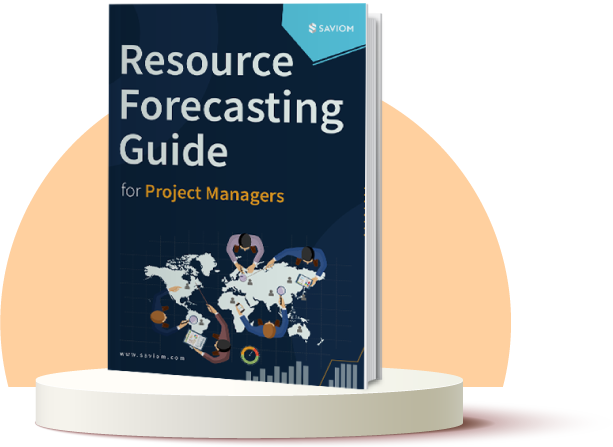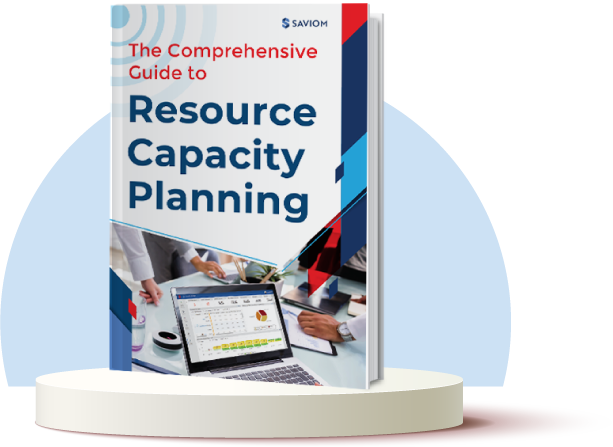Project management is a composite discipline of processes, principles, skills, knowledge, and experience required to meet its deliverables amid various project constraints.
One such constraint is the resources that can have a spiraling effect on other constraints like time and budget if not managed properly. Therefore, for successful project delivery, it is imperative to plan, schedule, and manage resources efficiently.
The resource manager is responsible for selecting the best resources as per the project manager‘s request. Moreover, he/she has to ensure the resources are available and are suitable for the tasks.
There are various limitations, such as budget, project duration, skills, etc., that you have to maintain while assigning resources. Finding the right person at the right time can be challenging. But this work could get a lot simpler if you had certain principles for guidance.
In this blog, we’ll be discussing the project management principles that can guide resource managers in their job and make their work a lot easier.
First, let’s understand the basic principles of project management.
What are the basic principles of project management?
As per PMBOK, project management principles are the fundamental guidelines that one should follow for successful project delivery. However, it does not have a consolidated list of the principles but some specific rules that apply to most projects.
These principles provide a solid foundation to the project management processes and ensure the efficient use of resources. Here is a rundown of the basic principles of project management:
Project objectives and goals
Any project is approved to serve a purpose. As a manager, you should be aware of what you want to achieve from the project. The goals and objectives must be clearly defined, measurable and achievable. Without these, your project will lose focus and get derailed.
Project constraints
Any factor that can impact the delivery of your project is considered a project constraint. To ensure timely delivery of projects and within budget, managers must manage project constraints efficiently. Some of the substantial project constraints are:
- Project budget
- Project Scope
- Project timeline or schedule
- Resources required for the project
- Project risks
Project life cycle
Every project has a definite start and a finish point within which you should achieve the end goal. It is known as the project life cycle. As per the PMI, there are generally five stages in a project lifecycle, namely:
- Initiation or conception.
- Planning of the project.
- Execution of the plan.
- Monitoring and controlling the process.
- Project closure.
The manager must fulfill the project’s goals, manage every constraint, and ultimately deliver the project within the end date.
Read More: What is Project Lifecycle and How to Get it Right?
What project management principles every successful resource manager must know?
The resource manager’s job is to provide the necessary resources for the project. He/she must have complete awareness about all the resources in the enterprise and ensure that the right resource is allocated to the right project. But, without precise knowledge about the project, he/she can’t do what is expected. Thus, a resource manager must follow certain principles that will help make the work easy.
Here is a rundown of all the principles that a resource manager must follow:
Alignment with business goals and objectives
Setting project goals and objectives help identify the destination and also pave the way to get there. For any project, the goals and objectives must be:
- Specific: The plan should cater to a particular need.
- Measurable: It must be quantifiable.
- Attainable: The end result should be realistic.
- Relevant: It should align with other business objectives.
- Time-bound: The goal must have a defined end.
Since resources are the critical drivers of a project’s success, the resource manager must know the end goal. Moreover, resource managers have to cater to multiple projects simultaneously; end goals make it easy to understand the criticality of the projects. Based on that, he/she will know which project is of the highest priority and assign resources to that one first.
Besides, the resource manager has to convey the goals and objectives to the resources. It will enhance their clarity on what is expected from them and add value to it.
Understanding the project structure
The project structure will stand on four pillars, namely :
- Project goal.
- Resources.
- Timeline.
- Budget.
As a resource manager, you must know all the stages that will help determine the final goal. Based on that, you can assign the required resources for the period.
Since resource costs constitute a significant portion of the project budget, you should be aware of the same. It will help you to create an appropriate resource mix to deliver the project within the stipulated funding. Besides, finding a cost-effective global resource from a low-cost location instead of assigning a high-cost local one will help stay within the budget.
Lastly, you must also be aware of the project interdependencies. For instance, let’s say two projects are running in parallel, which requires similar resources. But, the second project will start after the first project gets completed. So, as a resource manager, you can allot a single resource for both. That way, both the cost and the deadline remain in check.
Different project milestones and associated deliverables
For timely delivery, it is essential to review the project’s progress at various stages. So, as per the project’s requirement, milestones are created, which are considered mini-projects with their own deliverables. For example, let’s assume there is an interior designing project with predefined milestones and deliverables. As a resource manager, you have assigned a designer for only the initial phase of designing and not for the subsequent steps.
To roll out the resource to another project after the phase is complete, you must ensure that the milestone and deliverables are achieved. And for that, you should have a clear understanding of these two.
Keeping tabs on the milestones and deliverables will ensure that you assign a specific resource to another project at the right moment. That way, you confirm that the team member doesn’t end up on the bench.
Read More: How to Manage Resource Effectively with Precision
Overall project resource fulfillment plan
Resource fulfillment planning helps the resource manager identify, forecast, and allocate resources to the projects at the right time and cost. For example, let’s assume that there is a software development project. The project manager has looked after the client’s requirements, assessed the project’s scope, and evaluated the resource demand. He/she has requested resources from resource managers to fulfill this demand.
As the resource manager, you must assess the new requirement, find out the gap between the demand and the available workforce, and look for ways to fill this gap. You may either acquire new resources from the market or juggle resources available within the organization.
Resource fulfillment planning is a crucial part of project management. It helps the resource manager in:
- Forecasting all resource requirements for pipeline projects in advance
- Identifying the excess or shortage of resources by comparing the resource demand against the existing capacity
- Making the right resources available for the right project at the right time and avoid last-minute hiring activities
- Making data-driven decisions and implementing the proper resourcing measures at the right time
- Minimizing project resource costs significantly.
A clear understanding of project roles and responsibilities
A lack of clarity around roles and responsibilities can create confusion among the team members. When resources don’t know their interdependencies, unnecessary conflicts arise. The resource manager has to clearly understand critical team member’s roles to help everyone work well together. At an organization level, roles and responsibilities can be divided into four categories:
- Program Management level
- Project Board level
- Project Manager level
- Team level
The resource manager should know the roles and responsibilities to make sure that there are no overlaps. For instance, a project manager may require a single resource to take on multiple responsibilities or need various resources to do a single job. The resource manager has to inform the resources about their specific duties so that there is no confusion.
Read More: How to Manage Resource Effectively with Precision
Allocation of right resources to the right project
Ensuring the right resources are assigned to the right projects is critical for successful project delivery. When you allocate an experienced resource to a generic position, it can cause lower employee engagement and spike the project resource cost. On the contrary, if you assign a junior resource for an important role, it will create employee burnout and cause project delays.
As a resource manager, you must assign resources to projects based on their skills, previous experience, availability, or project budget. Also, you need to ensure that the resources have enough capacity to deliver upcoming projects. Moreover, when the project manager spots problems such as employee overutilization and uneven workload, the resource manager has to help by reallocating resources or assigning new people to the team.
Competent resource allocation can be facilitated using an efficient resource management solution that captures relevant data in real-time. So, based on their skills, experience, availability, and costs, managers can assign them to projects. One can also take corrective measures to avoid under or overallocation in advance. You can also mobilize resources from non-billable to strategic/billable work to improve profitability.
Collaboration between project team members
There is a saying in project management that it is 90% communication. A project’s success depends on healthy communication within the project team and with other stakeholders as well. Here are some of the reasons why communication is necessary:
- Keeping stakeholders engaged
- Coordinating tasks and schedules
- Data-driven decision-making and problem-solving
- Identifying and resolving conflicts
- Managing risks and issues
The resource manager needs to connect with the resources from time to time that he/she has supplied to a specific project. It will help him/her act on the feedback received if there is a mismatch of any expectation. Whether it’s email, text messaging, a chat service, or a communication platform, resources can reach their respective resource managers to discuss any specific issue.
To bolster productivity, workplace morale, and employee engagement in the project goals, resource managers need to foster an environment of open communication and active listening.
Read More: 11 Ways to Improve Cross-Departmental Collaboration
Receive performance feedback of resources from the project manager
During project execution, resources are provided to a project manager to complete specific responsibilities. The resource managers have full control over the assignment of resources, but he/she doesn’t have any input into the individuals’ performance evaluations. Many times, the project manager assesses the resources and creates accurate performance reports.
Sometimes resource managers also play the role of line managers for specific resources. In this situation, he/she is responsible for providing the project-related feedback and taking appropriate action if required. When employees get feedback, it makes them aware of the areas where they need to improve. Thus, helping them increase their productivity as well as their efficiency.
Receiving performance feedback on a regular basis helps resources grow; it helps them effectively correspond with their managers and follow directions. It allows the employees to engage better at their job, making the whole project better.
Read More: Using the Resource-based View Strategy for a Competitive Advantage
Reverse feedback from the resources
Collecting feedback from employees reveals what they think of the project or the project manager. When you get their feedback, it helps you shape future decisions, operating procedures, and training programs.
For instance, surveys and questionnaires will identify working issues like a bossy manager, latent friction between resources, and so on. Here are some of how feedback from resources helps:
- Regular feedback from resources keeps everyone on track. It lets the project manager know of his/her shortcomings and improves his leadership.
- It promotes honesty and trust between the team members and creates a friendly work environment.
Succession planning of critical resources
Projects depend on highly skilled resources to carry out the most critical tasks. Yet, many organizations do not have a backup plan in case a vital resource leaves the organization.
As a resource manager, you have to review the staffing levels and develop a succession plan to address the potential retirement/prolonged absence of critical resources. This activity can be jointly taken up with the project manager. The project manager identifies the critical resources and then discusses the backup option with the resource manager. With a plan in place, you can identify the actions to address changes that could occur when essential resources leave the project.
With succession planning, you can forecast future resource demands. That way, you get the time to develop the top resources you currently have, minimize skill gaps with resourcing measures, and so on.
Succession planning can be subjective, but here is a rundown of the ways to create a successful succession plan:
- Identify the critical resource demands in the organization.
- Determine the responsibilities, competencies, and requirements for the position.
- Assess existing resources or recruit resources to determine who has the potential to grow into the position.
- Establish a resource pool of workers who can mitigate the skill gaps.
Read More: What is Workforce Planning, and How to Master it for Business Efficiency?
Conclusion
In a nutshell, these project management principles can be universally applied by every resource manager. Following them judiciously, coupled with a robust resource management tool, one can keep the project on schedule and within budget.
SAVIOM Solution
SAVIOM has over 20 years of experience helping multinational clients manage their resources efficiently and effectively. With over 20 years of experience, this Australian-based MNC has a global presence across 50 countries and has helped 100+ clients meet their specific business goals. Saviom also provides tools for project portfolio management, professional service automation, and workforce planning software. So, SAVIOM can help your business to establish an efficient system geared towards your specific business challenges.










